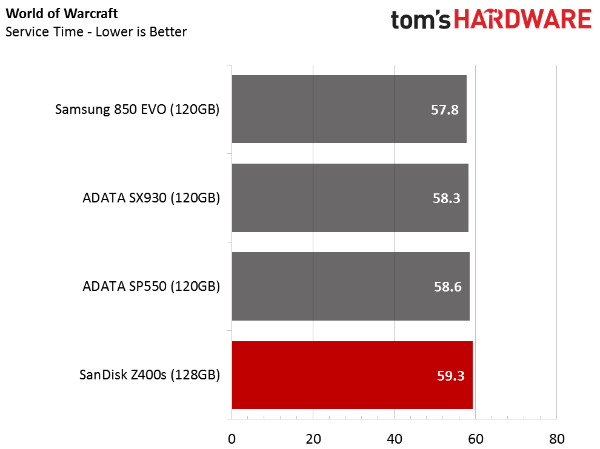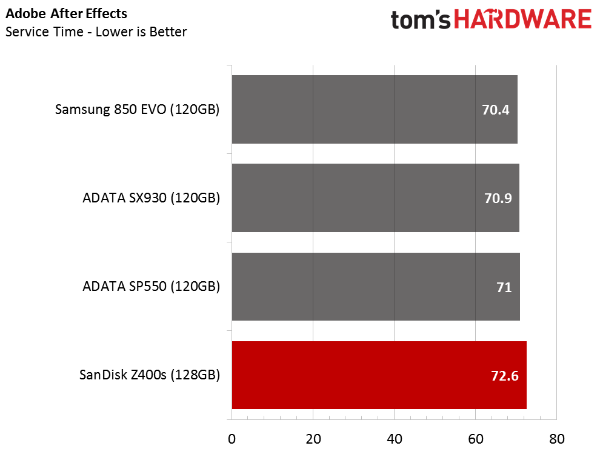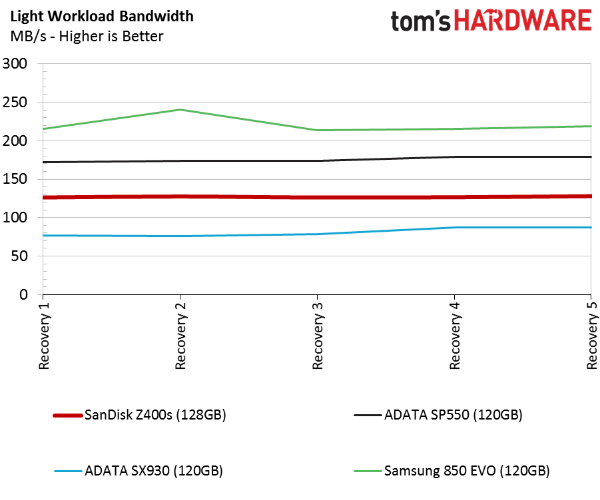SanDisk Z400s SSD Review
SanDisk has the exclusive on Silicon Motion's SM2246XT controller. What's more, we got our 128GB Z400s for just $.25/GB. But is this a true low-cost contender, or just a cheap SSD?
Why you can trust Tom's Hardware
Real-World Software Performance
PCMark 8 Real-World Software Performance
For details on our real-world software performance testing, please click here.










In real-world workloads, the Z400s falls to the bottom of our charts. Every. Single. One. This gives us a good idea of what we can expect from low-end tier-one builds in 2016, particularly when the machines include unnamed SSDs.
Total Storage Bandwidth
This chart coveys the average throughput from all of our real-world tests. There is a big gap between SanDisk's Z400s and Samsung's 850 EVO, which actually sells for less money.
PCMark 8 Advanced Workload Performance
To learn how we test advanced workload performance, please click here.



The Z400s doesn't take a beating from the comparison drives in our recovery tests, at least not by as much as we expected. Without over-provisioning and DRAM, it's harder for an SSD to quickly clean its flash.
Latency Test



For me, the user experience matters more than any other measure of SSD performance. But nobody would care if I just came out and said which SSD I prefer without quantitative data to back me up. Access time tests are the best way to show how responsive any given platform "feels".
It shouldn't come as a surprise that the Z400s isn't a good choice for heavy workloads. The drive is less responsive than two competing models, though really, none of the low-cost SSDs are suited for taxing environments.
Get Tom's Hardware's best news and in-depth reviews, straight to your inbox.
Notebook Battery Life
For more information on how we test notebook battery life, click here.


Even with low-power DDR3, DRAM consumes a lot of power in comparison to flash memory. The Z400s without RAM scores one of the best battery life test results we've ever measured. When SandForce launched DRAM-less controllers, we saw the same thing. Over time, performance-hungry vendors simply found ways to reincorporate DRAM and still compete on the power side.
Under battery power, when the system buses are in a reduced power state, all of the SSDs in our chart perform similarly. This means the latency is comparable, as is throughput.
Current page: Real-World Software Performance
Prev Page Mixed Workload And Steady State Next Page Conclusion
Chris Ramseyer was a senior contributing editor for Tom's Hardware. He tested and reviewed consumer storage.
-
ZolaIII Would actually like to see the 240 GB model & dose it catches up at least reasonable with declared write speeds.Reply
Whole topic is a dead fish until we see first implementation next year that will use 3D XPoint RAM instead of DRAM for caching purposes. -
zodiacfml Nothing to see here except the OEMs who will probably save more by choosing this drive.Reply -
Duken4evr Newegg has Adata 128GB drives on sale for $38. Deal abound out there. OEMs may buy these for cheap so they can advertise their $400 laptop has an SSD, but the rest of us smart shoppers can score deals on better drives for our upgrade purposes.Reply -
Marcus Zettergren Part of the conclusion just doesn't make sense even though i agree the Evo is so much better.Reply
As a potential upgrade, the Z400s is a fairly poor prospect, largely because of its price. In terms of value, Samsung's 850 EVO just wrecks every other company's attempt to compete. With the 128GB Z400s at $45 and the 120GB 850 EVO going for $68, we have to recommend Samsung's offering.
Unless my maths are way off, which it very well could be, the EVO is 62% more/GB. For a gaming disk, the Z400 is just as good as the EVO, and i suspect for a thin ultrabook with a "U" cpu, the cpu will be the bottleneck long before an SSD would be a showstopper. -
photonboy Marcus Zettergren,Reply
Gaming performance (which mainly only affects load times) is but one use case scenario. The CPU isn't going to be the bottleneck either, though low-cost notebooks can be limited by the main chipset of the motherboard, though even then it wouldn't be a total bottleneck but could limit performance.
How the CPU, chipset, and different scenarios work isn't a simple calculation.
I think this is GREAT to have an offering like this. I know fast SSD's seem important to most people but they way my sister uses her PC she wouldn't know the difference. It would still boot up pretty quick and then she's mostly in an office environment.
It's a lot faster than an HDD at times, reasonably inexpensive, and won't take several seconds to come out of standby mode like an HDD. -
nekromobo ReplyIf we want to push solid-state storage into lower-end systems, the expensive DRAM has to go.
According to Anandtech this December 2015:
The average spot price of one 4Gb DDR4 memory chip rated to run at 2133MHz was $2.221 at press time, according to DRAMeXchange,
So for a DRAM in SSD thats 2.221$ well spend (Ok, maybe it increases cost 4$ but anyway...)
Make it DDR3 and youll save 50cents. -
CRamseyer There is a bit more to it than just the physical DRAM. The controller has to have provisions in place for it, the extra design in the PCB, other components to support the DRAM and so on. It all adds up when companies are fighting to find a way to shave off a few Dollars at a time.Reply -
photonboy Reply17193485 said:There is a bit more to it than just the physical DRAM. The controller has to have provisions in place for it, the extra design in the PCB, other components to support the DRAM and so on. It all adds up when companies are fighting to find a way to shave off a few Dollars at a time.
Exactly.
Let's do some more meaningful algebra which I'm making up of course but know to be quite possible:
1) Profit margin of laptop-> $10
2) Savings on SSD (total) vs faster SSD-> $5
Profit is DOUBLED!
Most people will just see that it's an SSD and the capacity on the entry or mid-tier devices this would be aimed for. Saving $5 can make a huge difference in profits since as said they're fighting over scraps a lot of the time.
Some mobile devices were actually just BREAKING EVEN due to the tight competition and price drops. -
uglyduckling81 Reply
1) Profit margin of laptop-> $10
2) Savings on SSD (total) vs faster SSD-> $5
Profit is DOUBLED!
Just tell me again how a $10 profit increased to a $15 profit is double?

